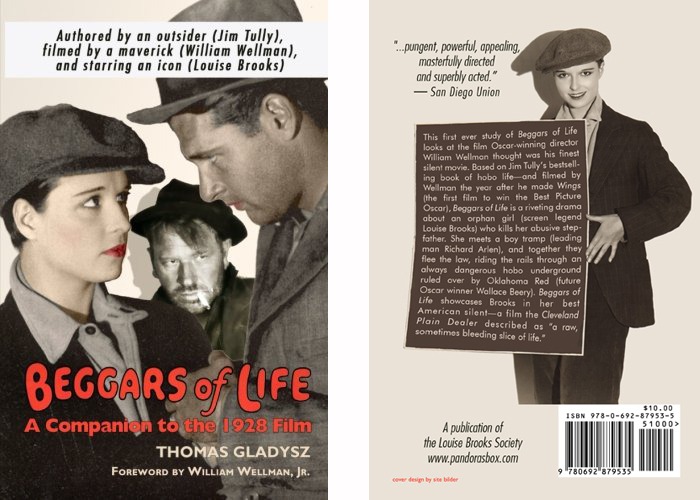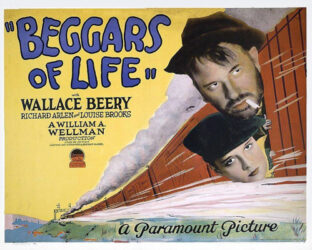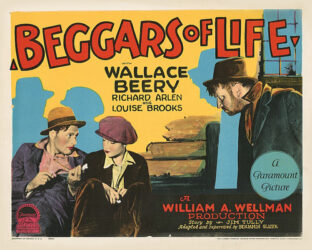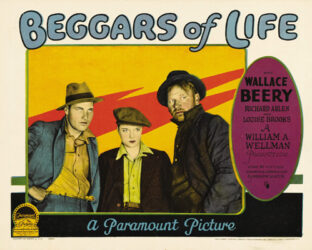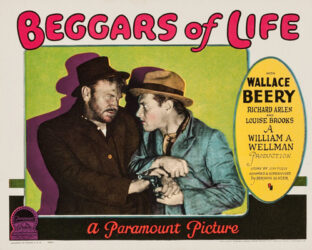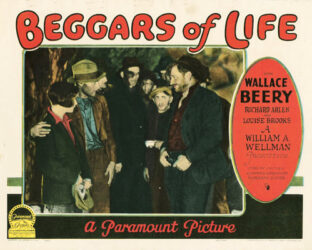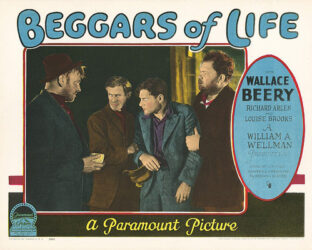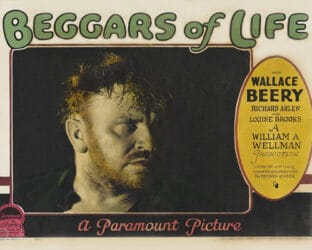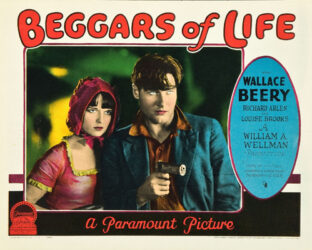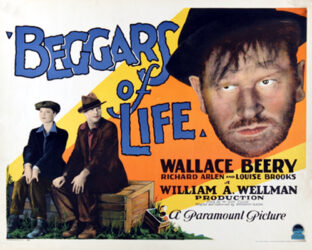![]() Directed by William Wellman the year after he made Wings (the first film to win an Academy Award), Beggars of Life is a terse drama about a girl (Louise Brooks) dressed as a boy who flees the law after killing her abusive stepfather. With the help of a young hobo, she rides the rails through a male dominated underworld in which danger is close at hand. Picture Play magazine described the film as “Sordid, grim and unpleasant,” adding, “it is nevertheless interesting and is certainly a departure from the usual movie.”
Directed by William Wellman the year after he made Wings (the first film to win an Academy Award), Beggars of Life is a terse drama about a girl (Louise Brooks) dressed as a boy who flees the law after killing her abusive stepfather. With the help of a young hobo, she rides the rails through a male dominated underworld in which danger is close at hand. Picture Play magazine described the film as “Sordid, grim and unpleasant,” adding, “it is nevertheless interesting and is certainly a departure from the usual movie.”
Beggars of Life is based on the 1924 novelistic memoir of the same name by Jim Tully, a celebrated “hobo author” highly regarded by H.L. Mencken and other literati of the time. Though shot as a silent and released in that format, Beggars of Life has the distinction of being Paramount’s first sound film: a synchronized musical score, sound effects, a few lines of dialogue and a song were added to some prints at the time of the film’s release. Advertisements for the film boasted “Come hear Wallace Beery sing!” The gravel-voiced character actor and future Oscar winner plays Oklahoma Red, a tough hobo with a soft heart. Richard Arlen, who the year before had starred in Wings, plays a vagabond and Brooks’ romantic interest.
In 1928, Beggars of Life was named one of the six best films for October by the Chicago Tribune; it also made the honor roll for best films of the year in an annual poll conducted by Film Daily. Musical Courier called Beggars of Life ” . . . one of the most entertaining films of the littered season.” And Photoplay thought it “good entertainment.” Nevertheless, it is not especially well known today, and its grim story set among the desperate and the downtrodden drew mixed reviews upon release. One Baltimore newspaper said it would have limited appeal, quipping, “Tully tale not a flapper fetcher for the daytime trade.”
Louella Parsons, writing in the Los Angeles Examiner, echoed the sentiment when she stated, “I was a little disappointed in Louise Brooks. She is so much more the modern flapper type, the Ziegfeld Follies girl, who wears clothes and is always gay and flippant. This girl is somber, worried to distraction and in no comedy mood. Miss Brooks is infinitely better when she has her lighter moments.” Her cross-town colleague, Harrison Carroll, added to the drumbeat of disdain when he wrote in the Los Angeles Evening Herald, “Considered from a moral standpoint, Beggars of Life is questionable, for it throws the glamour of adventure over tramp life and is occupied with building sympathy for an escaping murderess. As entertainment, however, it has tenseness and rugged earthy humor.”
Critics in New York were also divided on the merits of Beggars of Life, and many of them instead focused on Brooks’ unconventional, cross-dressing appearance. In the New York Times, Mordaunt Hall noted, “Louise Brooks figures as Nancy. She is seen for the greater part of this subject in male attire, having decided to wear these clothes to avoid being apprehended. Miss Brooks really acts well, better than she has in most of her other pictures.” The New York Morning Telegraph stated, “Louise Brooks, in a complete departure from the pert flapper that it has been her wont to portray, here definitely places herself on the map as a fine actress. Her characterizations, drawn with the utmost simplicity, is genuinely affecting.” While Quinn Martin of the New York World wrote, “Here we have Louise Brooks, that handsome brunette, playing the part of a fugitive from justice, and playing as if she meant it, and with a certain impressive authority and manner. This is the best acting this remarkable young woman has done.”
Also getting attention for their role in Beggars of Life was Edgar “Blue” Washington. The Afro-American newspaper wrote, “In Beggars of Life, Edgar Blue Washington, race star, was signed by Paramount for what is regarded as the most important Negro screen role of the year, that of Big Mose. The part is that of a sympathetic character, hardly less important to the epic of tramp life than those of Wallace Beery, Louise Brooks and Richard Arlen, who head the cast.”
Girls dressed as boys, pastoral life gone wrong, the mingling of races, desperation depicted among the glitz and glamour of the twenties — there is a lot happening in Beggars of Life. It is, arguably, Brooks’ best American silent. [ Click below to listen to a vintage recording of the theme song to the film. ]
RELATED MATERIAL:
- Promotional Materials
- What the Critics Said
- Advertisements
- Bibliography
- Lulu by the Bay
DATABASE LINKS:
- Academy of Motion Picture Arts and Sciences
- AFI catalog
- All Movie Guide
- AlloCine (fr)
- BFI website (uk)
- Cinemacontext (nl)
- Det Danske FilmMuseum (dk)
- Filmvandaag (nl)
- Filmweb (pl)
- ICAA (es)
- IMDb
- Letterboxd
- MUBI
- Open Media
- Rotten Tomatoes
- SilentEra.com
- TCM.com
- TMDB
- Wikipedia
PREVIOUS Louise Brooks Film
NEXT Louise Brooks Film
STORY SYNOPSIS:
“Nancy lives in mortal fear of her foster father and, when he attacks her, she kills him in a moment of panic. The murder is discovered by Jim, a young hobo, who helps her to escape. Nancy dresses in men’s rough clothes, and she and Jim hop a freight; thrown off by the brakeman, they take refuge in a hobo camp, the leadership of which is bitterly contested between Arkansas Snake and Oklahoma Red. The encampment is broken up by detectives, and Jim and Nancy take refuge with Mose and a seriously ill tramp in an abandoned shack. Red unexpectedly shows up with a stolen car and women’s clothing for Nancy, helping her and Jim to escape in the car. The sick tramp dies, and Red, dressing him in Nancy’s rough clothes, places his body in a lumber car which he sets aflame. The pursuing detective kills Red, and Jim and Nancy (who is declared to be officially dead by the police) hop a passenger train for Canada.”
PRODUCTION HISTORY:
Production work on the film took place between May 18 and June 18, 1928, with location shooting near Jacumba, California taking place between May 30 and June 15. The film was released in both a silent and sound version; the sound version included music, sound effects, a bit of dialogue, and a song reportedly sung by Wallace Beery.
| CAST | |
|
Wallace Beery
|
Oklahoma Red |
|
Louise Brooks
|
The Girl (Nancy) |
|
Richard Arlen
|
The Boy (Jim) |
|
Edgar “Blue” Washington
|
Black Mose |
|
H.A. Morgan
|
Skinny |
|
Andy Clark
|
Skelly |
|
Mike Donlin
|
Bill |
|
Roscoe Karns
|
Lame Hoppy |
|
Robert Perry
|
The Arkansaw Snake |
|
Johnnie Morris
|
Rubin |
|
George Kotsonaros
|
Baldy |
|
Jacques Chapin
|
Ukie |
|
Robert Brower
|
Blind Sims |
|
Frank Brownlee
|
Farmer |
|
Guinn Williams
|
Baker’s Cart Driver |
|
Matt Gilman
|
Wallace Beery double |
|
Duke Green
|
stuntman (uncredited) |
|
Mike Donlin
|
undetermined role (uncredited) |
|
Jack Holbrook
|
Richard Arlen stunt double (uncredited) |
|
Harvey Parry
|
Louise Brooks stunt double (uncredited) |
| CREDITS | |
|
Studio:
|
Paramount Famous Lasky Corp. |
|
Producer:
|
Adolph Zukor and Jesse L. Lasky |
|
General Manager:
|
B.P. Shulberg |
|
Director:
|
William A. Wellman |
|
Assistant Director:
|
Charles Barton |
|
Writing Credits:
|
Benjamin Glazer and Jim Tully (screenplay), adapted from the book by Jim Tully; titles by Julian Johnson |
|
Cinematography:
|
Henry Gerrard |
|
Second Cameraman:
|
Guy Bennett |
|
Assistant Cameraman:
|
Cliff Shirpser and Bob Rhea |
|
Film Editor:
|
Alyson Shaffer |
|
Recording Director:
|
Roy Pomeroy (Movietone) |
|
Sound Editors:
|
Andy Newman, Merrill White |
|
Foley Recordist:
|
Benjamin Glazer |
|
Costumes:
|
Travis Banton, with Edith Head |
|
Makeup:
|
James Collins |
|
Property Man:
|
John Richmond |
|
Grip:
|
Mitch Crawley |
|
Assistant Grip:
|
Andy Durkins |
|
Format:
|
Silent version – black & white & sound version – black & white (Western Electric Movietone sound-on-film) |
|
Running Time:
|
9 reels (reported as 7,504 and 7,560 feet), reported as 80 and 87 minutes – elsewhere, The Netherlands: 2244 meters. United Kingdom: 7,400 feet |
|
Copyright:
|
September 21, 1928 by Paramount Famous Lasky Corp. (LP25642) |
|
Release Date:
|
September 22, 1928 |
|
Premiere:
|
September 18, 1928 at Paramount theater in New York City (sound version); earlier showings of the silent version took place in Indianapolis, Indiana and Salt Lake City, Utah beginning on September 1 |
|
Country of Origin:
|
United States |
ALTERNATE TITLES:
Under its American title, documented screenings of the film took place in Australia (including Tasmania), Bermuda, British Malaysia (Singapore), Canada, China, Dutch East Indies (Indonesia), France, India, Ireland, Jamaica, Japan, Korea, New Zealand, South Africa, and the United Kingdom (England, Isle of Man, Northern Ireland and Scotland). In the United States, the film was presented under the title Mendigos de la Vida (Spanish-language press) and Il Mendicante di Vita (Italian language press).
Elsewhere, Beggars of Life was shown under the title Les mendiants de la vie (Algeria); Bettler des Lebens (Austria); Meias indiscretag and Mendigos da vida (Brazil); Mendigos de la Vida (Chile); Mendigos de la Vida (Costa Rica); Mendigos de la Vida (Cuba); Žebráci života and Žebráky živote (Czechoslovakia); De Lovløses Tog (Denmark); Menschen Zijn Nooit Tevreden (Dutch East Indies – Indonesia); Elu wõõraslapsed and Eluvõõrad hinged (Estonia); Les mendiants de la vie (France); Az élet koldusai and Az orszagutak angyala (Hungary); I mendicanti della vita (Italy); Bettler des Lebens and Dzives ubagi (Latvia); Bettlers des Lebens (Les Mendiants de la Vie) (Luxembourg); Mendigos de vida (Mexico); Menschen Zijn Nooit Tevreden and Zwervers (The Netherlands); Ludzie bezdomni (Poland); Mendigos da Vida (Portugal); Strada cersetorilor and Sklaven des Shidjals (Romania); Mendigos de vida and Los mendigos de la vida (Spain) and Captaires de vida (Spain, Catalonian language); and Les mendiants de la vie (Switzerland).
STATUS:
The silent version of the film is extant, and notably dark, lesser quality, almost unwatchable dupes have been released on VHS and DVD and YouTube; the original sound sequences are presumed lost. A far superior print, once belonging to film historian William Everson, is housed at the International Museum of Photography and Film at the George Eastman House in Rochester, New York. This best surviving print is a 35mm preservation positive optically enlarged from Everson’s 16mm copy. The Eastman House print of Beggars of Life is occasionally screened at film festivals, and in 2017, it was released on DVD / Blu-ray by Kino Lorber. This disc features a new soundtrack recording, an informational booklet, as well as audio commentaries by the director’s son, William Wellman Jr., and Thomas Gladysz, Director of the LBS. The Kino Lorber release is the best available, and is highly recommended. Around the same time, Thomas Gladysz authored Beggars of Life: A Companion to the 1928 Film (PandorasBox Press), a detailed look at the making of the film.
RELATED ONLINE DOCUMENTS, MEDIA, LINKS, etc…:
Press Sheet (Library of Congress)
— Paramount, 1928
Thematic music cue sheet (George Eastman House)
— Paramount, 1928
Beggars of Life sheet music (Academy of Motion Picture Arts and Sciences)
— theme song tie-in
Beggars of Life sheet music (IMSLP sheet music library)
— theme song alt version
Coming Attraction Slide (Louise Brooks Society)
— scroll down for a particular film
“Beggars of Life” by William K. Everson (New York University)
— 1966 program notes for the Theodore Huff Memorial Film Society
“Beggars of Life” by William K. Everson (New York University)
— 1971 program notes for the Theodore Huff Memorial Film Society
“Two Silents with Louise Brooks” by William K. Everson (New York University)
— 1976 program notes for the New School
“Beggars of Life” by Laura Horak (San Francisco Silent Film Festival)
— 2007 program essay
“Beggars of Life” by Bryony Dixon (Google Books)
— book excerpt from 100 Silent Films (BFI, 2011)
“Beggars of Life: The Sounds of a Louise Brooks’ Silent Film” by Thomas Gladysz (Louise Brooks Society blog)
— blog about the film’s music
“Beggars of Life” by Cari Beauchamp (San Francisco Silent Film Festival)
— 2016 program essay
Beggars of Life: A Companion to the 1928 Film, by Thomas Gladysz (amazon.com link)
— an illustrated book about the film
